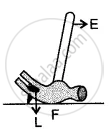Advertisements
Advertisements
प्रश्न
A 4 m long rod of negligible weight is to be balanced about a point 125 cm from one end and a load of 18 kgf is suspended at a point 60 cm from the support on the shorter arm.
- If a weight W is placed at a distance of 250 cm from the support on the longer arm to balance the rod, find W.
- If a weight 5 kgf is kept to balance the rod, find its position.
- To which class of lever does it belong?
उत्तर
(a) W × CE = 18 × DC
W × 250 = 18 × 60

∴ W = `(18 xx 60)/250`
∴ W = 4.32 kgf
(b) New W = 5 kgf
Let it be placed at a distance x from C on arm CB
∴ 5 × x = 18 × 60
∴ x = `(18 xx 60)/5`
= 216 cm = 2.16 m
(c) It belongs to class I lever.
APPEARS IN
संबंधित प्रश्न
Which class of lever will always have MA > 1 and why?
The diagram below shows a lever in use:

- To which class of levers does it belong?
- Without changing the dimensions of the lever, if the load is shifted towards the fulcrum what happens to the mechanical advantage of the lever?
State the principle of a lever?
Which class of lever found in the human body is being used by a boy when he raises the weight of his body on his toes?
The following belong to which class of lever?
A claw-hammer
The following belong to which class of lever?
Rowing of a boat
The following belong to which class of lever?
Knife
In the diagram shown alongside a claw hammer, mark the fulcrum (F) and indicate the directions of load (L) and effort (E) with arrows. What class of lever is it? Give one more example of this class of lever.

State the types (or kinds) of lever, and give two examples of each kind.
The length of a nut-cracker is 12 cm. A nut, when kept at a distance of 4 cm from its fulcrum, requires an effort of 100 gf to crack it. What force will be required to crack the nut without using the nut-cracker?
